EverQuest
Brave adventurers have been exploring the colorful 3D world of Norrath since February of 1999. EverQuest has grown and changed since then, and it will have a new expansion soon.
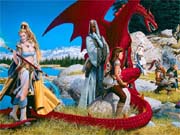
EverQuest
Developer: Verant Interactive
Publisher: Sony Online Entertainment
Release date: 2/28/1999
By Andrew Park
Verant's fully 3D online role-playing game, EverQuest, was first made available to the public in February of 1999, and it was met with much critical acclaim. It also immediately became popular with both fans of role-playing games and casual players. Since then, it's become increasingly popular at an almost alarming rate. In fact, Sony just celebrated its 300,000th EverQuest subscriber. Even now, tens of thousands of hopelessly addicted players log on to EverQuest's crowded servers every day and every night in the hopes of attaining the next level for their characters or of obtaining a magical weapon, piece of armor, or another item that will enhance their characters' power and effectiveness even further.
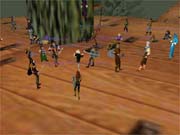
If you've ever played a fantasy role-playing game, you'll probably find EverQuest's premise and setting to be familiar, even hackneyed. That's because EverQuest borrows liberally from many previously existing sources, especially TSR's Dungeons & Dragons pencil-and-paper game. In EverQuest's fantasy realm of Norrath, you'll find cowardly goblins and ugly orcs; thieves that pickpocket and stab their enemies in the back; towering, ham-fisted hill giants that viciously pummel any adventurers they see; and any number of other common swords-and-sorcery archetypes. It's true that EverQuest has been criticized by many for its general lack of originality, but its reliance on classic fantasy character types, monsters, and imagery is also one of the main reasons why it's been so remarkably successful. That's because Verant's team of skilled artists and modelers used EverQuest's robust graphics engine to render each of these fantasy archetypes in colorful and detailed 3D. If you've ever played a tabletop or pen-and-paper game, or if you're a fan of computer role-playing games, you'll probably be able to identify many of Norrath's fantastical denizens at a glance. And even if you aren't a fantasy role-playing expert, chances are you'll still be able to quickly acclimate yourself to EverQuest's environs and inhabitants; if you've heard of griffins, elves, and dwarves, you'll likely recognize their well-animated, fully 3D representations in Norrath. It's this effective combination of familiar fantasy imagery and attractive 3D graphics that makes EverQuest so insidiously addictive, at least at first: It's easy to lose yourself in a fantasy gameworld that actually looks like a fantasy gameworld.
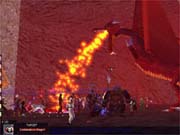
But once you've familiarized yourself with EverQuest's appearance and the lay of the land in Norrath, you'll discover the game's intriguing character-class dynamics; each character class is distinctive, and each has its own particular strengths and weaknesses. One of the most enjoyable things about EverQuest (and part of the game's appeal) is attaining a new skill - which includes combat and trades such as fletching, smithing, and brewing - or a new rank of magic spells for your character. Another intriguing aspect of EverQuest is how the strengths, weaknesses, and skills of different character classes work with those of other character classes in an adventuring party. These class skills become all the more important in the high-level game - here, several groups must work together in tough dungeon raids to slay mighty dragons.
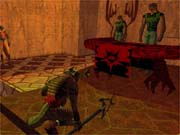
However, these interesting character-class dynamics really come into play only when you're fighting, which is the most prominent and dominant part of EverQuest. Every new skill or set of spells is tied to a character's level; the only way to gain levels is to earn experience points either by performing quests (many of which are short-term, simplistic tasks that involve fetching items for certain characters), or, much more reliably, by fighting monsters. And most of the game's quests tend to involve killing monsters (and retrieving items from the monsters' corpses). More than a few critics have denounced EverQuest for being nothing more than a simplistic, hack-and-slash game of killing monsters. What's worse is that in the original game, many of the most powerful enemies (and the ones that tended to drop the best loot and most powerful items) tended to be on static spawns - that is, they would appear in a single fixed place in an area and, once defeated, would reappear in the same exact area. As such, players with more advanced and more powerful characters would try to claim these spots as their own; if any newcomers showed up, there was usually an ugly dispute.
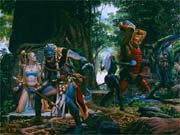
EverQuest suffered from other problems as well, like showstopping bugs that would cause players' corpses (and any belongings on those corpses) to become invisible or get stuck in walls. Certain bugs would even cause players to fall right through the ground on which they were standing "into the world geometry"; this would cause them to sustain tremendous damage. However, since the game's launch, Verant's development team has worked constantly to fix both technical and gameplay balance issues.
About ten months or so after the game's release, overcrowding became one of the biggest gameplay issues. Verant addressed this issue by opening up new areas in the game, such as the underwater dungeon of Kedge Keep; the extradimensional planes of fear, hate, and sky; and the lairs of two of Norrath's mightiest dragons, Lady Vox and Lord Nagafen. These new areas offered new challenges to advanced, high-level players but did little to help alleviate crowding in high-traffic areas filled with mid- and low-level players. Verant offered to "split" several of the game's servers (characters reside on a specific server) and to move many of the characters from older servers to brand-new ones; and it has continued to open new servers for players to start new characters. Then, in March 2000, Verant released The Ruins of Kunark, the first official expansion for EverQuest. The expansion included the enormous tropical continent of Kunark, home to the Iksar, an entirely new player-character race of lizardmen. It also included a tremendous amount of open areas, populated with all-new monsters, many of which yielded a good amount of experience (to help players advance their characters' levels) as well as powerful and rare magic weapons and items. The Ruins of Kunark included not only enough new zones and content to seriously address the game's overcrowding problems, but it also included graphical enhancements such as larger, more detailed 3D textures and animated scenery.
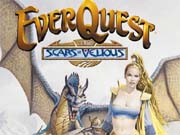
Despite all the changes it's been through, and despite all the criticism it continues to receive, EverQuest is still going strong today. More people play EverQuest now than ever, and many are eagerly awaiting the game's next official expansion, The Scars of Velious, which is currently scheduled to be released this December. The expansion will include the new continent of Velious, a snowy and frozen wasteland populated with centaurs, wild dwarves, a new breed of frost giant, and other new creatures. Velious will also feature new treasure and items; a new, customizable game interface; and - its most anticipated new feature - the means to customize your character's appearance by modifying the armor or clothing he's wearing.
Next: Read our Q&A with EverQuest producer Jeff Butler
Q&A with EverQuest Producer Jeff Butler
We interviewed EverQuest and The Scars of Velious producer Jeff Butler to ask about EverQuest's beginnings, its progress, and its future.
GS: Thanks for taking the time for this interview. EverQuest has been a remarkably successful game, and it's changed a great deal since its initial release. Would you say that the game is more or less where it should be in terms of development? What's the best change that's been implemented since its release?
JB: I continue to be pleased with EverQuest as it matures, and I am fairly satisfied with the game at this stage. That said, we look forward to refining and adding to the game in the future.
In my opinion the best change since release was the implementation of randomized spawns and loot drops for the Kunark expansion.
GS: Some people attribute EverQuest's success to its excellent graphics, its familiar fantasy archetypes, or its social aspects. What would you say has been the key to the game's success so far?
JB: I think that for each player the answer might be different, but I would say that compelling gameplay and character advancement are key, in addition to the points that you mentioned above.
GS: One of the most important issues for EverQuest's players and developers is game balance. What has or have been the most difficult thing(s) to keep balanced in the game?
JB: The most challenging balance issue has been controlling the power and rarity of weapons, armor, and items.
GS: One of the things for which EverQuest is most commonly criticized is "camping" - that is, players often sit in one place and wait for monsters and/or items to spawn and respawn. Verant has taken measures against this problem, including the play-nice policy, which dictates that players who are of a much higher level should yield spawn points to lower-level characters. How effectively have these and other measures addressed the camping issue?
JB: Design features introduced in the Kunark expansion addressed camping issues to a great degree. They are very effective in the areas where they have been implemented. To further reduce this problem it is our intent to redo portions of the existing world in this style over time.
The play-nice policy was not intended to directly address the camping issue, but rather to provide a policy for GM [Game Master] intervention in disputes between players. If you refer to the posted policy at www.everquest.com, it does not include a "yield rule" based on character level.
GS: Since its release, EverQuest's trade skills have improved considerably; jewelry making, tailoring, and blacksmithing have been gradually expanded, and alchemy was finally implemented. Are there any other trade-skill improvements in the works? Any new items that either general tradesman characters or specific character classes can construct?
JB: Yes, there are limitless possibilities for expanding the trade skills. For the Velious expansion, we are adding to the class and deity-specific trades. There will also be more cultural products available, craftable only by specific races.
GS: The Ruins of Kunark was an excellent expansion that had lots of new content for beginners and advanced players alike. Could you please describe some of what players can expect in the next add-on, The Scars of Velious?
JB: Velious is designed for players of 30 to 60 levels, based on the level range of the majority of our player base. In addition to the 16 new zones and content, we will be updating the user interface and adding over 150 new armor textures for the player characters, along with new helmet designs and weapons.
Oh, and don't forget the snow. Expect lots of snow!
GS: Finally, is there anything else you'd like to add about EverQuest?
JB: On behalf of the EQ Live and Scars of Velious teams, I would like to thank all our players and GameSpot for your continued support for EverQuest and invite everyone to explore the lost continent of Velious in December!
Got a news tip or want to contact us directly? Email news@gamespot.com
Join the conversation